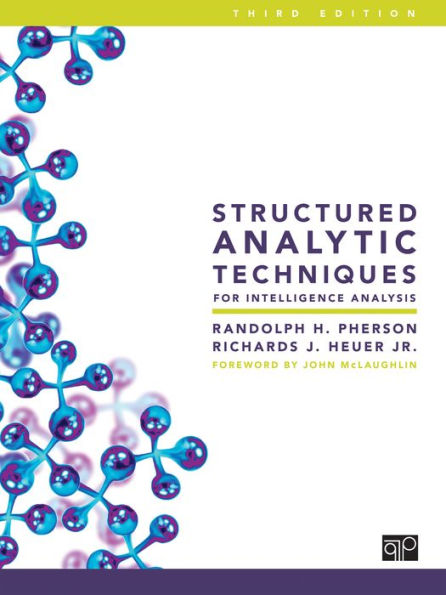
Structured Analytic Techniques for Intelligence Analysis
384
Structured Analytic Techniques for Intelligence Analysis
384eBookThird Edition (Third Edition)
Related collections and offers
Overview
—Charles E. Wilson, University of Detroit Mercy
The Third Edition of Structured Analytic Techniques for Intelligence Analysis showcases sixty-six structured analytic techniques—nine new to this edition—that represent the most current best practices in intelligence, law enforcement, homeland security, and business analysis. With more depth, detail, and utility than existing handbooks, each technique is clearly and systematically explained. Logically organized and richly illustrated, and with spiral binding and tabs that separate techniques into categories, this book is an easy-to-use, comprehensive reference.

Product Details
| ISBN-13: | 9781506368917 |
|---|---|
| Publisher: | SAGE Publications |
| Publication date: | 12/05/2019 |
| Sold by: | Barnes & Noble |
| Format: | eBook |
| Pages: | 384 |
| Sales rank: | 597,364 |
| File size: | 6 MB |
About the Author
Randolph H. Pherson is president of Pherson Associates, LLC; CEO of Globalytica, LLC; and a founding director of the nonprofit Forum Foundation for Analytic Excellence. He teaches advanced analytic techniques and critical thinking skills to analysts in the government and private sector. Mr. Pherson collaborated with Richards Heuer Jr. in developing and launching use of Analysis of Competing Hypotheses, and he developed several analytic techniques for the CIA’s Sherman Kent School, many of which were incorporated in his Handbook of Analytic Tools and Techniques. He coauthored Critical Thinking for Strategic Intelligence with Katherine Hibbs Pherson, Cases in Intelligence Analysis: Structured Analytic Techniques in Action with Sarah Miller Beebe, and several other guides for analysts on writing, briefing, indicators, and managing the production process. Mr. Pherson completed a twenty-eight-year career in the Intelligence Community in 2000, last serving as National Intelligence Officer (NIO) for Latin America. Previously at the CIA, Mr. Pherson managed the production of intelligence analysis on topics ranging from global instability to Latin America, served on the Inspector General’s staff, and was chief of the CIA’s Strategic Planning and Management Staff. He is the recipient of the Distinguished Intelligence Medal for his service as NIO and the Distinguished Career Intelligence Medal. Mr. Pherson received his B.A. from Dartmouth College and an M.A. in international relations from Yale University.
Richards J. Heuer Jr. is best known for his book Psychology of Intelligence Analysis and for developing and then guiding automation of the Analysis of Competing Hypotheses (ACH) technique. Both are being used to teach and train intelligence analysts throughout the Intelligence Community and in a growing number of academic programs on intelligence or national security. After retiring from the Central Intelligence Agency (CIA), Mr. Heuer was associated with the Intelligence Community in various roles for more than five decades until his death in August 2018. He has written extensively on personnel security, counterintelligence, deception, and intelligence analysis. Mr. Heuer has a B.A. in philosophy from Williams College and an M.A. in international relations from the University of Southern California. He also pursued graduate studies at the University of California at Berkeley and the University of Michigan.
Table of Contents
FiguresForeword by John McLaughlin
Preface
Chapter 1 • Introduction and Overview
1.1 Our Vision
1.2 Role of Structured Analytic Techniques
1.3 History of Structured Analytic Techniques
1.4 The Expanding Use of Structured Analytic Techniques
1.5 Selection of Techniques for This Book
1.6 Quick Overview of Chapters
Chapter 2 • The Role of Structured Techniques
2.1 Two Types of Thinking
2.2 Developing a Taxonomy of Structured Analytic Techniques
2.3 Dealing with Cognitive Limitations
2.4 Matching Cognitive Limitations to Structured Techniques
2.5 Combating Digital Disinformation
Chapter 3 • Choosing the Right Technique
3.1 The Six Families
3.2 Core Techniques
3.3 Selecting the Right Technique
3.4 Projects Using Multiple Techniques
3.5 Common Errors in Selecting Techniques
3.6 Making a Habit of Using Structured Techniques
Chapter 4 • Practitioner’s Guide to Collaboration
4.1 Social Networks and Analytic Teams
4.2 Dividing the Work
4.3 Value of Collaborative Processes
4.4 Common Pitfalls with Small Groups
4.5 Benefiting from Diversity
4.6 Advocacy versus Objective Inquiry
4.7 Leadership and Training
Chapter 5 • Getting Organized
5.1 Sorting
5.2 Ranking, Scoring, and Prioritizing
5.3 Matrices
5.4 Process Maps
5.5 Gantt Charts
Chapter 6 • Exploration Techniques
6.1 Simple Brainstorming
6.2 Cluster Brainstorming
6.3 Nominal Group Technique
6.4 Circleboarding™
6.5 Starbursting
6.6 Mind Maps and Concept Maps
6.7 Venn Analysis
6.8 Network Analysis
Chapter 7 • Diagnostic Techniques
7.1 Key Assumptions Check
7.2 Chronologies and Timelines
7.3 Cross-Impact Matrix
7.4 Multiple Hypothesis Generation
7.5 Diagnostic Reasoning
7.6 Analysis of Competing Hypotheses
7.7 Inconsistencies Finder™
7.8 Deception Detection
7.9 Argument Mapping
Chapter 8 • Reframing Techniques
8.1 Cause and Effect Techniques
8.2 Challenge Analysis Techniques
8.3 Conflict Management Techniques
Chapter 9 • Foresight Techniques
9.1 Key Drivers Generation™
9.2 Key Uncertainties Finder™
9.3 Reversing Assumptions
9.4 Simple Scenarios
9.5 Cone of Plausibility
9.6 Alternative Futures Analysis
9.7 Multiple Scenarios Generation
9.8 Morphological Analysis
9.9 Counterfactual Reasoning
9.10 Analysis by Contrasting Narratives
9.11 Indicators Generation, Validation, and Evaluation
Chapter 10 • Decision Support Techniques
10.1 Opportunities Incubator™
10.2 Bowtie Analysis
10.3 Impact Matrix
10.4 SWOT Analysis
10.5 Critical Path Analysis
10.6 Decision Trees
10.7 Decision Matrix
10.8 Force Field Analysis
10.9 Pros-Cons-Faults-and-Fixes
10.10 Complexity Manager
Chapter 11 • The Future of Structured Analytic Techniques
11.1 Limits of Empirical Analysis
11.2 Purpose of Structured Techniques
11.3 Projecting the Trajectory of Structured Techniques
11.4 Role of Structured Techniques in 2030
